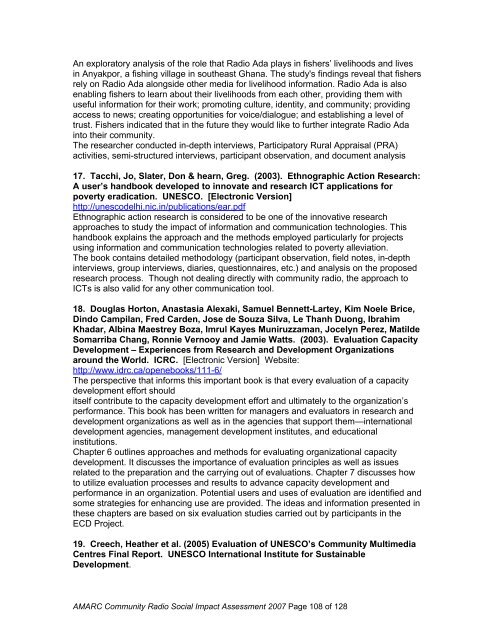An exploratory analysis of the role that Radio Ada plays in fishers’ livelihoods and livesin Anyakpor, a fishing village in southeast Ghana. The study's findings reveal that fishersrely on Radio Ada alongside other media for livelihood information. Radio Ada is alsoenabling fishers to learn about their livelihoods from each other, providing them withuseful information for their work; promoting culture, identity, and community; providingaccess to news; creating opportunities for voice/dialogue; and establishing a level oftrust. Fishers indicated that in the future they would like to further integrate Radio Adainto their community.The researcher conducted in-depth interviews, Participatory Rural Appraisal (PRA)activities, semi-structured interviews, participant observation, and document analysis17. Tacchi, Jo, Slater, Don & hearn, Greg. (2003). Ethnographic Action Research:A user’s handbook developed to innovate and research ICT applications forpoverty eradication. UNESCO. [Electronic Version]http://unescodelhi.nic.in/publications/ear.pdfEthnographic action research is considered to be one of the innovative researchapproaches to study the impact of information and communication technologies. Thishandbook explains the approach and the methods employed particularly for projectsusing information and communication technologies related to poverty alleviation.The book contains detailed methodology (participant observation, field notes, in-depthinterviews, group interviews, diaries, questionnaires, etc.) and analysis on the proposedresearch process. Though not dealing directly with community radio, the approach toICTs is also valid for any other communication tool.18. Douglas Horton, Anastasia Alexaki, Samuel Bennett-Lartey, Kim Noele Brice,Dindo Campilan, Fred Carden, Jose de Souza Silva, Le Thanh Duong, IbrahimKhadar, Albina Maestrey Boza, Imrul Kayes Muniruzzaman, Jocelyn Perez, MatildeSomarriba Chang, Ronnie Vernooy and Jamie Watts. (2003). Evaluation CapacityDevelopment – Experiences from Research and Development Organizationsaround the World. ICRC. [Electronic Version] Website:http://www.idrc.ca/openebooks/111-6/The perspective that informs this important book is that every evaluation of a capacitydevelopment effort shoulditself contribute to the capacity development effort and ultimately to the organization’sperformance. This book has been written for managers and evaluators in research anddevelopment organizations as well as in the agencies that support them—internationaldevelopment agencies, management development institutes, and educationalinstitutions.Chapter 6 outlines approaches and methods for evaluating organizational capacitydevelopment. It discusses the importance of evaluation principles as well as issuesrelated to the preparation and the carrying out of evaluations. Chapter 7 discusses howto utilize evaluation processes and results to advance capacity development andperformance in an organization. Potential users and uses of evaluation are identified andsome strategies for enhancing use are provided. The ideas and information presented inthese chapters are based on six evaluation studies carried out by participants in theECD Project.19. Creech, Heather et al. (2005) Evaluation of UNESCO’s Community MultimediaCentres Final Report. UNESCO International Institute for SustainableDevelopment.AMARC Community Radio Social Impact Assessment 2007 Page 108 of 128
http://portal.unesco.org/ci/en/files/22129/11477736959CMC_Evaluation_Final.pdf/CMC+Evaluation_Final.pdfThis evaluation assesses what can be learned from the pilot phase that will bothstrengthen the CMC model and improve UNESCO’s programming for future CMCs, inparticular through the scale-up initiative. It was conducted by the International Institutefor Sustainable Development between April and October 2005. An evaluation frameworkwas approved by the UNESCO Internal Oversight Service. In addition to a review ofCMC documentation, site An additional 26 in person or phone interviews wereconducted with UNESCO stakeholders, donors, partners and peers active in the field ofICTs for development (ICT4D).20. S. Batchelor, P Norrish ed. (2005). Framework for the Assessment of ICTPiolent Prodects: beyond Monitoring and Evaulation to Applied Research.InvoDev. Website: http://www.infodev.org/en/Document.4.aspxThis handbook, commissioned by infoDev and prepared by a team at GAMOS, reviewsthe experience of infoDev and others in supporting ICT pilot projects in developingcountries, and proposes a framework for assessing the effectiveness of these pilotprojects. It provides guidance not only on how to design effective monitoring andevaluation (M&E) components of ICT pilot projects, but also on how to go "beyond"traditional M&E to develop more forward-looking evidence of the potential broaderimpact of such pilot projects if taken to a larger scale.Monitoring and Evaluation (M&E) at the project level is not enough, there is a need forapplied research. Undertaking M&E during and after an ICT pilot projectis standard good practice and is used for accountability and learning. This is acomprehensive and detailed methodological proposal to evaluate ICTs, that can beused for impact assessment of community radio stations.21. Cinco, Cheekay. (2005). Gender Evaluation Methodology For Internet andICTs a Learning Tool for Change and Empowerment. Association for ProgressiveCommunications (APC). Website: http://www.apcwomen.org/gem/The evaluation model pays special attention to self and social change – understandingthe dynamic relationship between an ICT initiative on both self and social change.Learning for Change uses “self” to mean individuals, organisations and communitiesinvolved in an ICT initiative. Evaluation that focuses on self-change examines thedynamic relationship between ICT initiatives and the way individuals, organisations andcommunities operate.The evaluation model, “Learning for Change”, is developed along the book. Thisimportant publication draws from a wealth of experiences in Asia, Central Europe, Africaand Latin America. GEM is not only a tool for gender evaluations. Nor is it just a guide ora manual that breaks down gender concepts and makes it relevant for ICT projects.22. Mytton, Graham. (1999). Handbook on Radio and Television AudienceResearch. UNESCO. [Electronic Version] Website:http://unesdoc.unesco.org/images/0012/001242/124231Eo.pdfVery strong in methodology of audience research, however this manual does notconsider community radio specifics, such as participation, ownership and evaluationresearch that involves communities in the decision-making process.The manual describes in a comprehensive manner the methodology for audienceresearch, with detailed chapters on: audience measurement or quantitative research;audience opinion and reaction; qualitative research; desk research; data analysis, etc.AMARC Community Radio Social Impact Assessment 2007 Page 109 of 128
- Page 1 and 2:
COMMUNITY RADIOSOCIAL IMPACTASSESSM
- Page 3 and 4:
Chapter 10: Community Media by and
- Page 5 and 6:
ForewordThe World Association of Co
- Page 7 and 8:
monitoring and research process was
- Page 9 and 10:
organizations interviewed tell only
- Page 11 and 12:
The Roundtables, the electronic For
- Page 13 and 14:
good. It did not involve a traditio
- Page 15 and 16:
capabilities for monitoring, impact
- Page 17 and 18:
Each of these components of the ext
- Page 19 and 20:
Description of the ActivitiesThe th
- Page 21 and 22:
PART II. Global Challenges to Commu
- Page 23 and 24:
if we want to achieve poverty reduc
- Page 25 and 26:
Community Radio is part of a politi
- Page 27 and 28:
freedom of expression and military
- Page 29 and 30:
has abandoned those responsibilitie
- Page 31 and 32:
Chapter 5: The Amman Declaration 27
- Page 33 and 34:
10. Independent media can play a si
- Page 35 and 36:
• Promote and support the trainin
- Page 37 and 38:
communication strategies within the
- Page 39 and 40:
This said, it becomes clear that in
- Page 41 and 42:
as rural black women, impoverished
- Page 43 and 44:
national languages. “For several
- Page 45 and 46:
Measuring ImpactChapter 7: The Impa
- Page 47 and 48:
meaningful social change indicator
- Page 49 and 50:
Chapter 8: Why Assess Community Rad
- Page 51 and 52:
doing the work they are chartered t
- Page 53 and 54:
B. Assessing the effectiveness of c
- Page 55 and 56:
• How do you participate in this
- Page 57 and 58: While community media can take many
- Page 59 and 60: From this perspective, communicatio
- Page 61 and 62: affordable means to express their o
- Page 63 and 64: At the same time there is growing r
- Page 65 and 66: Chapter 10: Community Media by and
- Page 67 and 68: Tallies from meetings showed that e
- Page 69 and 70: Chapter 11: What role did community
- Page 71 and 72: RM: [LAUGHS.] So we sang the news,
- Page 73 and 74: commission, tasked with developing
- Page 75 and 76: Most of the Eastern African countri
- Page 77 and 78: need to constantly be guided by ask
- Page 79 and 80: time are settled with custom law, i
- Page 81 and 82: Chapter 14: Community Radio and Med
- Page 83 and 84: ensuing global imbalance in informa
- Page 85 and 86: platforms and technologies? How can
- Page 87 and 88: CR should increase its role in faci
- Page 89 and 90: Clarifying the nature of Community
- Page 91 and 92: Amplify the voices of the poor and
- Page 93 and 94: Harmonize AMARC bodies and structur
- Page 95 and 96: (c) Solidarityactivitiesincludingre
- Page 97 and 98: (d) Interactiveplatform forprogramm
- Page 99 and 100: evaluation(d) Disseminationof resul
- Page 101 and 102: expectations of AMARC relate to all
- Page 103 and 104: Part VI : AnnexesAnnexe 1: Essentia
- Page 105 and 106: One of the chapters is on “Progra
- Page 107: customs and practices of the tribal
- Page 111 and 112: Radio Douentza was one of the first
- Page 113 and 114: 38. Querre, Francois. (1991). Les M
- Page 115 and 116: Handbook for Developing Countries.
- Page 117 and 118: The Pelican discussion, which has b
- Page 119 and 120: Through the opinions of 30 communic
- Page 121 and 122: andhttp://www.cfsc.org/pdf/measurin
- Page 123 and 124: www.urcm.netUnited Grassroots Radio
- Page 125 and 126: www.mci.gov.veZimbabwe So this is
- Page 127 and 128: Please indicate how this impact cou
















